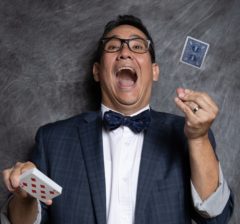Many years ago I decided to not use fire in my show. The decision was based on not wanting to deal with regulations that vary from state to state or venue to venue. It was just too much of a challenge to do it in a legal way. I didn’t wan to have an anchor routine in my show that uses fire, then have to cut it because a venue tells me I can’t have fire.
With the shift to virtual shows, I’ve been playing with using fire a little bit. For example I created a “flaming bill change” where you light a one dollar bill on fire, and it changes into a twenty dollar bill. I think this is a great use of fire to enhance the magic moment of the bill change.
I’ve been using my “flaming jalapeno” for a lot of virtual content, and then this week I’ve finally started to use the “fire breather” for my flea circus. I’m having fun using a little bit of fire, however I don’t expect any of it to make it into my live, in person show.
I guess one of the silver linings to doing virtual shows is that I get to explore using fire!
Category: Tricks
Magic Wheel…
Way back in the early summer when my state had first started to reopen after the initial pandemic shutdown, and friend texted me this picture of a game wheel at a thrift store for $2.99.
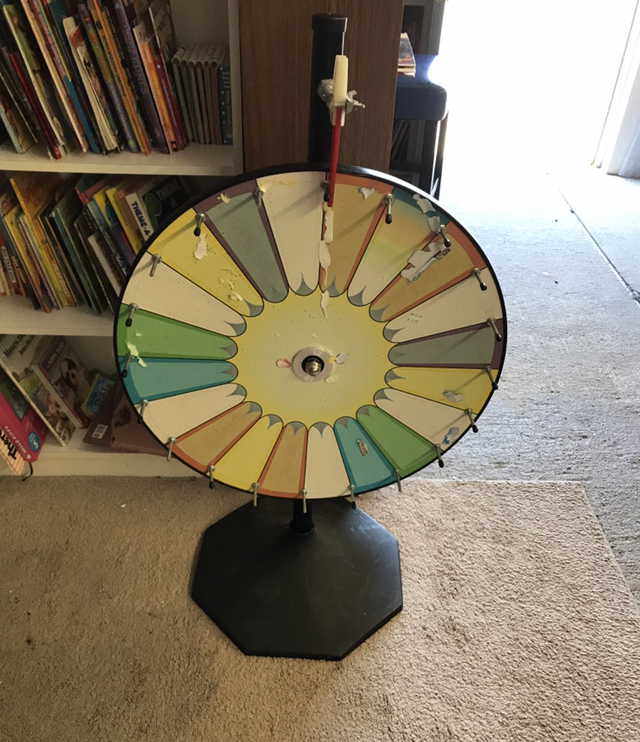
I drove up and bought it. It needed some work, the whole from was stained, and have some sort of glue residue in it. What I found interested was that it was heavier duty that most of the game wheels that I’d seen before. The wheel is two feet in diameter, and made of thick wood, so it’s heavy. The pole it’s on looked like the top pole of a speaker stand. I took it home and it fit into the base of a speaker stand, that would allow me to use it without a table. I threw away the plastic base in the picture above.

This then ended up sitting in my shed for months, as I didn’t want to deal with cleaning up the wheel. I didn’t have an idea of exactly what I was going to do with it. Then I remembered reading about trick called Wheel of Mind by Amir Lustig and Hiam Goldenberg. I wasn’t exactly sure of the what it did, aside from that it was a force. Hiam puts out some pretty clever stuff, and for $15, I figured why not check it out.
Wheel of Mind uses twelve spaces and my game wheel has 20 spaces. Luckily the trick still works with more spaces. The other challenge is that Wheel of Mind uses both sides of the wheel. It turns out it’s really easy to remove the game wheel I have from the stand and turn it over. Now that I have what I’m going to use the game wheel for, it’s time to clean it up.

The first step was scraping all of the glue off of it. However the actual wheel was stained by whatever pen had been used on it previously. The next step was to remove the pins, and peel off the graphic from the front.
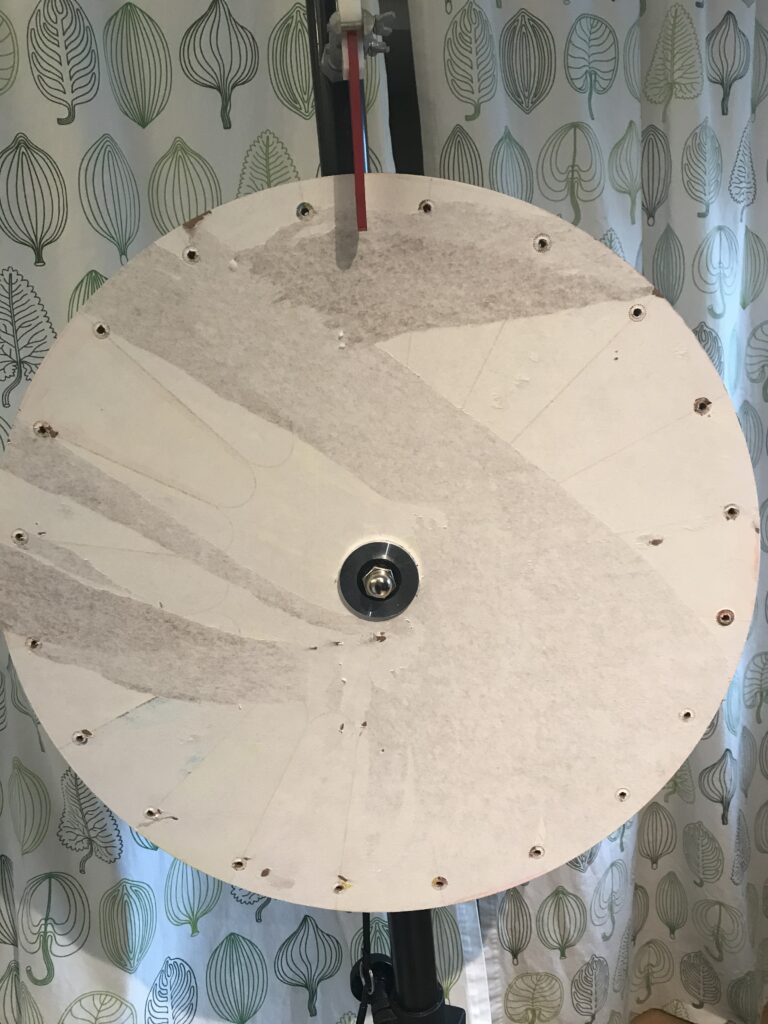
I recovered it with white contact paper on the front and back. Then using electrical tape, I made some lines and wrote the numbers in.

For less than $30 (that’s including buying Wheel of Mind) I now have a fun looking prop that will force something. I probably wouldn’t travel with this, unless I was doing a run of shows. It’s mostly for virtual shows, it’s also a cool set piece to have behind me.
Pre-Adapting…
Lately I’ve been thinking about what live, in person magic shows will look like in 2021. I’m fairly optimistic that in person shows will happen, however they will look different. I think the majority of them will be no contact magic shows. That means you can’t have people from the audience come up on stage to help with the show.
I’m trying to plan for that now, and not have to adapt a week before a show. One thing I’m doing today is making a display holder for the front of my case. This is simply a tray that I can set flat props into so that they are upright and visible to the audience.
Here’s what the frontside looks like:
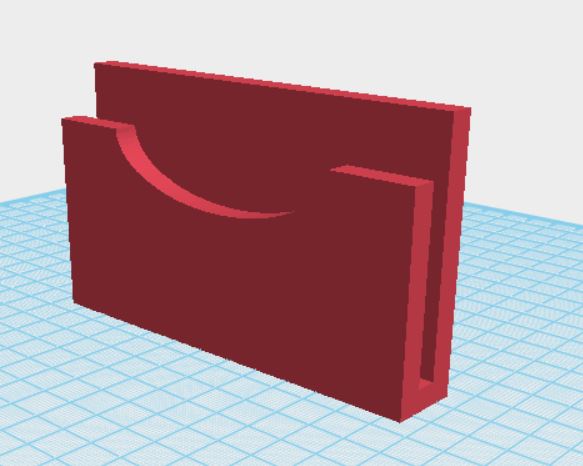
It’s currently being 3d printed in black. It is about 4.5 inches wide and 3 inches tall.
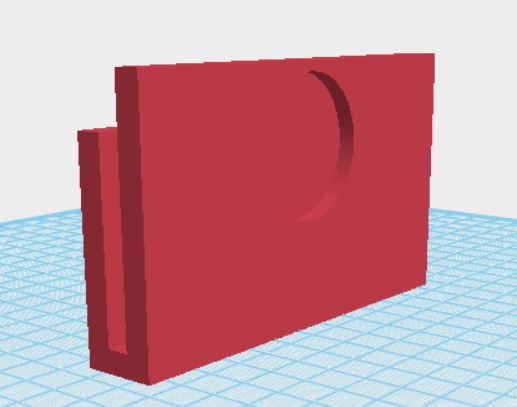
There’s a cut out in the back that I’m going to glue a magnet into. There’s already a magnet inside my case that I can stick this to. This is a simple solution as I don’t use a table to hold props I’m actively using.
Planning for the reality of what’s coming is probably better than hoping everything will be back to where it was a year ago. Even if all restrictions are lifted, the bonus is that I’m developing some new material!
The Living Room Sessions…
One of the best kept secrets in magic is Nathan Coe Marsh. All of the material he does is well thought out and super solid! A year or two ago he sold a series of videos called “The Living Room Sessions“. These videos were in depth teaching videos of routines he performs around the world. I just noticed he’s got a special on them right now, and you should check them out:
https://nathancoemarsh.com/black-friday/
All of the routines work in a stand up / stage context and don’t need someone from the audience to physically come on stage. This is going to be a very important condition for at least the next year.
Here’s a sample of one of his routines:
That’s a solid opening routine. He walks out, and gets right into the trick. The trick is good but the kicker is AMAZING!
Cricut Magic…
A couple of weeks ago my daughter got a Cricut Machine which is used for die cutting. I’ve been meaning to start coming up with ideas for magic tricks with it. The first thing I did was have her try to cut a dollar bill. It worked! That lead to my next idea, which is cutting a playing card into a dollar bill. This is a pretty lame idea as far as ideas go.
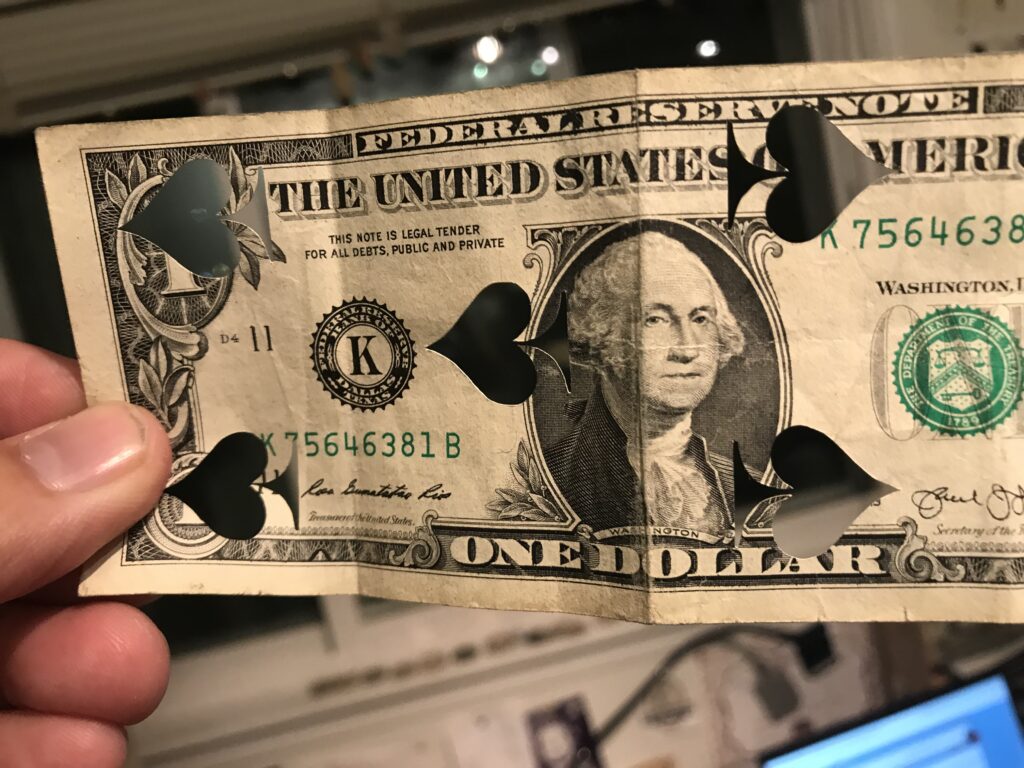
Most of my ideas were using it to cut reveals into the dollar bill. However I did have one idea, that was a little more inspired. If there was a thought bubble drawn with a marker on it. The thought bubble would go around part of the serial number. The serial number then rearranges itself for a reveal, and the bill could be given out.
Method wise, it wouldn’t be hard to do and I’ve got a few ideas for how to accomplish it.
Thanksgiving Creativity…
Well, today is Thanksgiving in the United States, and I’m going to remind you that holidays are a great way to be creative. Here’s a trick that I made for Thanksgiving 4 or 5 years ago:
It’s an easy way to take an existing trick, theme the prop and you’ve got a unique feeling routine. Every now and then I take a look at the list of “National Day’s” and use that as my starting point to work on new routines. Usually these routines aren’t for my show, they are a creative exercise.
PCAM Magic Convention…
Last weekend I attended the PCAM magic convention. It was a lot of fun, and they did a good job of keeping the day moving, it went from 10am to 8pm, then unofficially till about midnight.
When the booker approached me to perform at the convention, I decided to pitch something a little different from an act or lectures. I mentioned the little cooking demos I’ve done, and could do a cocktail for them. They like the idea and I got to do one of little mixology video for them!
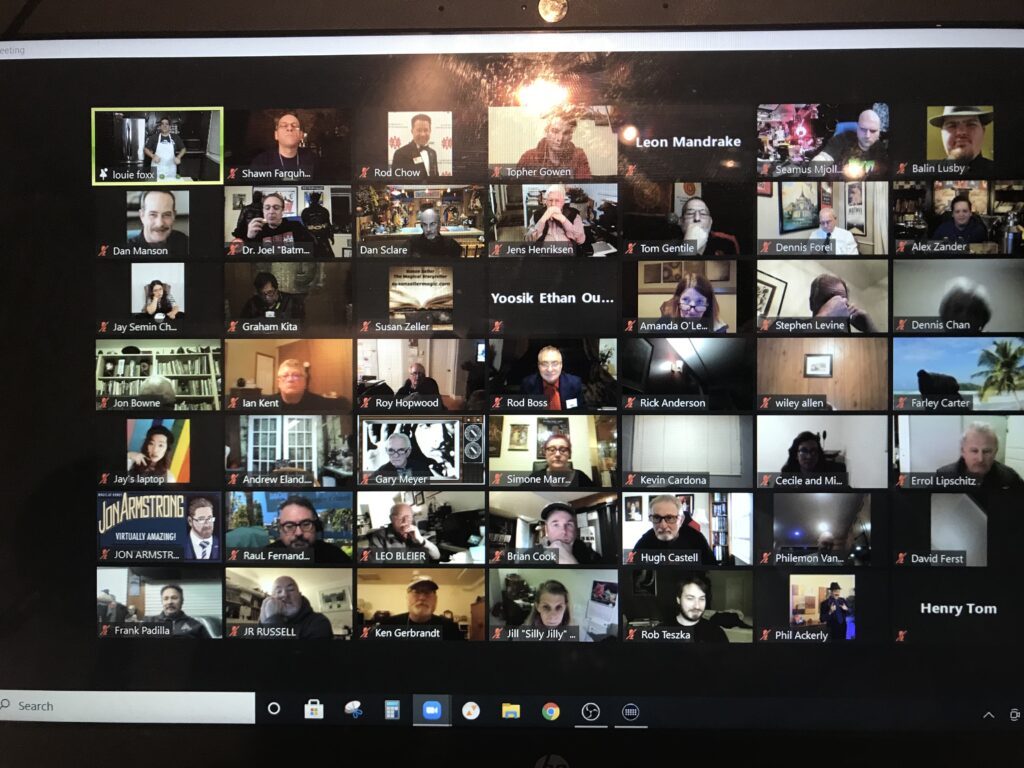
It went over well! One of the fun things performing for magicians is when you do unexpected things. In that routine there are a couple of interest to magicians. There’s a production of two rats, which is interesting and the flaming jalapeno pepper. The pepper always surprises me that magicians get excited about that. there have been “flaming” objects around for years, not sure why this one makes an impression…unless it’s that it makes sense as a prop.
I’m glad that my whacky little presentation went well. I’d love to do more and more of these over zoom. It’s a different style of performing magic and I’m really enjoying it.
New Shell Game Set…
Shell game sets are the one thing in magic that I collect. Recently TCC put out a shell game set as part of their 10th anniversary releases. They were only $29 with free shipping, so I picked up a set.
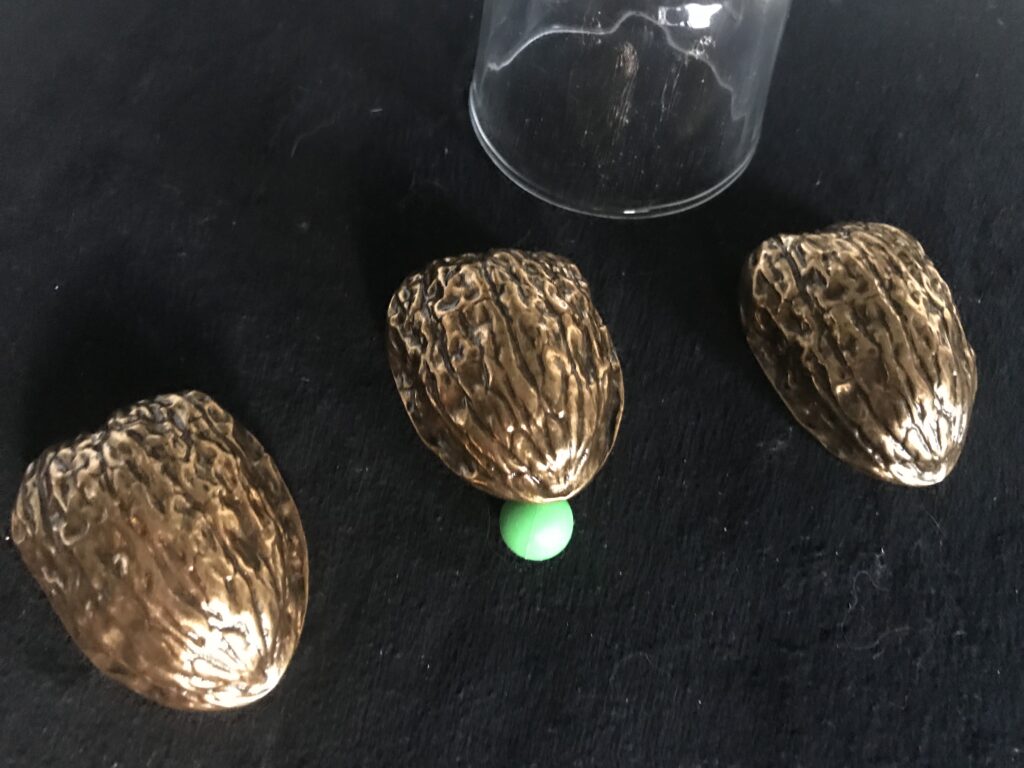
The picture above is the set was sent to me. Here’s the TCC video:
My review is pretty much, for $29 and if you can get them shipped free, they are fine. They aren’t breaking any new ground. They are brass walnut shells, with no added features aside from the weight of them being brass. They are completely workable and do what they are supposed to do.
If I had to choose between the Magic Maker’s gold shells and the TCC ones, I’d go with the TCC shells. However, a better choice would be to save a few more bucks and get a better made shell game set.
The Harvard Crimson…
Got a fun surprise today. A while ago I was interviewed by The Harvard Crimson, and the article came out!

Magicians and audiences from Boston and around the world gathered together virtually for the Boston Magic Lab’s final show of 2020. With backdrops varying from simple bedrooms and offices to more elaborate studio setups, six performers presented the audience with impossible effects ranging from a perfect prediction of a spectator’s thoughts to a chosen playing card emerging from a jar of vegemite. In the show’s unique digital format, viewers spammed “1”s into the chat in lieu of applause, and volunteers were toggled from viewers to panelists when they interacted with the performers.
Now a year old, the Boston Magic Lab is one of the latest additions to the Boston arts scene. The group hosts a monthly open-mic for magicians to test out new material. The show is entirely free for audiences, who are instead encouraged to contribute to local charitable organizations. The magicians aren’t paid to perform — rather, they receive in-depth feedback for their routines.
The Boston Magic Lab was founded by Felice T. Ling, a social anthropologist and street magician who is a regular performer at Faneuil Hall. After having a chance to test some new cabaret material at the Toronto Magic Company, she was inspired. A few years later, Ling’s magician friends from Toronto visited Boston, and they sent out a call for local magicians to come hang out. It was then that Ling met many of the magicians who would join the Boston Magic Lab crew. “[I] realized that there’s a lot of little tribes of magicians in the area who were also craving the same thing that I was looking for,” Ling said, “which was community and a place to perform and try out new stuff.”
While open mics exist in stand-up comedy, the concept of a magic open mic is a relatively new idea. “I think part of the challenge of magic is a lot of people do it as a hobby, which is great, but then it’s always tough to find places to perform live, where you can test new material and you can be, quote unquote, you can be bad to get better,” said magician Adrian Saw, an Australian financial trader based in Singapore who has performed magic in comedy clubs throughout Asia. An open mic platform gives new magicians an opportunity to practice and seasoned professionals a chance to take risks.
One of Ling’s goals for the organization is to spotlight local magicians. In pre-pandemic times, the Boston Magic Lab was housed in the Rozzie Square Theater. “Feeling like Boston is very important to us,” said Ling. “The goal is still to try and keep three slots for Boston area or New England area magicians.” Another of Ling’s goals is to showcase marginalized peoples. “There are so few magicians who aren’t white men, just to be blunt,” she said. “I think [representation]’s really important because for me, the first time I saw a magician on stage who looked kind of like me, that was huge.”
Like all the performing arts, magic has been struck a terrible blow by the pandemic and the subsequent closure of nearly all in-person venues. Magic carries a physicality that is distinctly lost in this virtual world. Viewing tricks through a screen is a significant change in the experience, not just for audiences, but for the magicians themselves.
“If I, for example, turned a coin into a solid steel ball, you just have to believe that what you’re seeing is a solid steel ball, you can’t actually feel it. You can’t actually see that this is a solid steel ball, no longer a coin, and that’s the most difficult part, because everything is visual, is no longer tangible,” said Jay S. Chun, an Edmonton based street performer known for her circus skills. “And as a street performer who works with a lot of, ‘Come close, feel my props, these are regular props, let’s do magic with them,’ is entirely out the window.”
Similar to stand-up comedy, magic relies heavily on feeding off of an audience’s energy — interpreting reactions and altering one’s performance in real time to create a unique and engaging show. Performing for a screen is very different from performing on the street, in a club, or on a stage. “For me, what this is is just a great big game of pretend,” said Benjamin L. Barnes, the current Entertainment Director at the Chicago Magic Lounge. “I am imagining what [people in the audience] look like, I am imagining that they’re having fun and so I’m having fun with them, never seeing them. It’s all just make believe. And I imagine things are going great … There was one point in the show where I said to everyone, ‘I can see some of you are clapping, thank you so much.’ I saw none of that, it’s just in my imagination.”
A virtual format does come with some benefits. “It’s been some of the most creative times of my life because I’m able to pursue stuff that I wouldn’t normally do,” said Louie M. Foxx, a Seattle based magician and two-time Guinness World Record holder, who has been experimenting with creating short pieces of pre recorded content.ADVERTISEMENT
Saw agreed, referencing a trick he did with a coin during the recent Boston Magic Lab performance — something that would usually be considered close-up magic. “I couldn’t really do that in a live environment, in a stand-up or comedy room because no one past the first row could see that coin, but in a Zoom environment where you’ve got the camera right there and the audience can see a tight frame, you can start using different things that you wouldn’t otherwise use in a live show.”
For now, virtual shows are the only option for most magicians. All of the Boston Magic Lab performers emphasized the importance of pivoting and taking advantage of this new opportunity. “Every single platform: TV magic, close-up magic, parlor, stage, they each have their own beauty to it, and you just have to try to find that beauty in every single one,” said Linda Hung, a recent graduate of Pace University currently based in NYC. “And virtual shows [are] just a new platform that people need to find the beauty [in].”
Barnes said that, if anything, magicians will be better performers after working in the virtual realm. “I think this situation has forced us to learn to connect with people more because of the obstacles of not being there with them physically … If you can connect with people through a camera, that’s a great skill to have.”
For the Boston Magic Lab, moving beyond physical space means reaching a larger circle of magicians. “I think switching online has helped me find people in the New England area, actually, that I did not know of here,” said Ling.
The performing arts scene is bound to emerge from the pandemic as a changed industry. Much of in-person magic involves working with volunteers, passing around props, and choosing cards, but in a post-pandemic world concerned about hygiene, this is unlikely to come back any time soon. All of the performers agreed that the virtual magic show is here to stay, even after a return to in-person venues is possible. “It’s inexpensive, you can connect people in different geographic locations, and it’s a lot of fun, and I don’t think it’s going to go away just because we can be together in person again … honestly, I think it’s good. It’s another avenue through which magicians can make a living, which is fantastic,” Barnes said.
Audiences may be Zoom-fatigued, but there are still reasons to seek out virtual magic shows, even more so than other virtual entertainment. “[In] most of those other art forms it’s a fixed performance and an audience member would see that same show if they watched that virtual performance five times,”Saw said. “But in a magic show, you’re going to have audience members making different decisions … I think people have been so isolated that just sitting, watching passively a Zoom show is not really what people want in this kind of environment — they want to be involved. They want to have their camera on. They want to talk, they want to make decisions, and I would say magic is probably one of the only art forms in a virtual medium where people can do that.”
As for the Boston Magic Lab, they intend to resume performances in January 2021 after a two-month hiatus, during which they plan to rework and improve their show and continue to build an unpretentious and inclusive community.
We’re not a nonprofit, we’re not an official organization,” said Ling. “We’re just a group of friends who want to put together a good show.”
By Sam F. Dvorak, Contributing Writer
Side Steal…
At night when I’m hanging out with the family watching TV, usually I’m dinking around with a deck of cards. Frequently I’m working on a fancy cut, I try to be able to do a little bit of the cardistry so the kids at magic conventions think I’m less of a dinosaur. Sometimes I work on new card sleights, or just try to keep the rust off of old ones.
The last week or so I’ve been playing with the side steal. It’s a move I’ve done for a long time and can do it, but I don’t do it exceptionally. When I do it in a live performance, it’s an attitude thing, versus a technique thing. Usually when I do it, I use Scotty York‘s method for the side jog, which automatically side jogs the card.
Sometimes I do the proper side steal technique where you push the card into a squared deck, steal the card and either palm it, or move it to the top. I’ve been working on my technique to get it into full palm using proper technique the last week. It’s starting to look a lot better, I still have a studder between the side jog and full palm. I’m working to smooth that out. It’ll take time…
